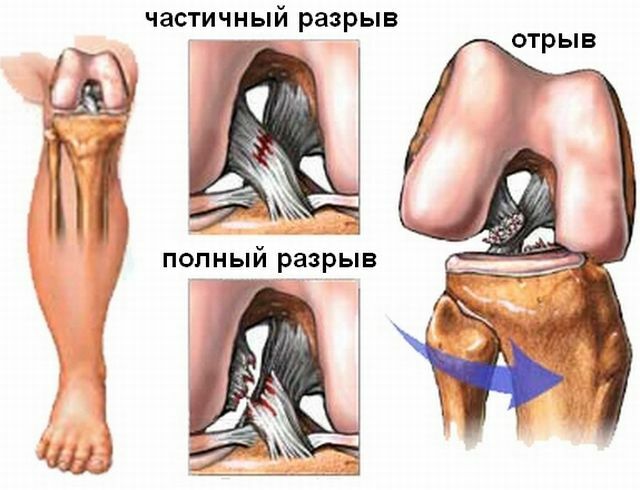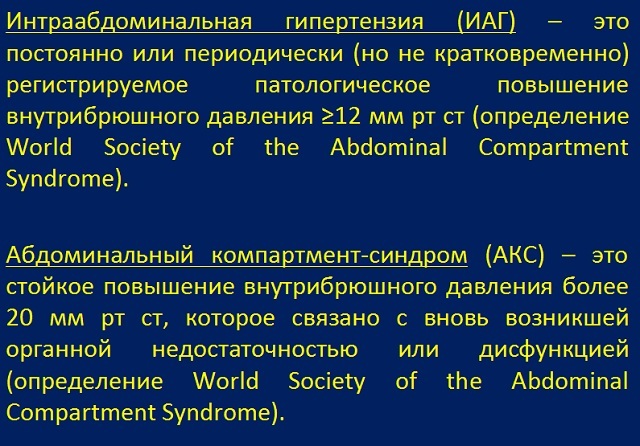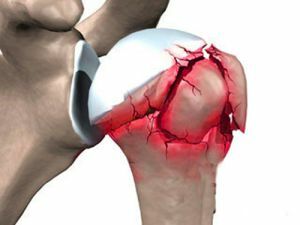 Fracture of the shoulder is a rather rare phenomenon, occurs in 7% of cases of .
Fracture of the shoulder is a rather rare phenomenon, occurs in 7% of cases of .
The rarity of the presented ailment is based on high bone density, as well as "fit" to the body.
Most of the shoulder bone fractures were obtained in car accidents - people often put their hands forward in the event of a collision.
Depending on the location and shape of the fracture, further treatment and the need for surgical intervention depend.
Article Contents
- anatomical reference
- fractures Classification
- cause injury
- Symptoms of fractures according to
- localization upper part of the humerus
- humerus body
- of the distal
- First Aid
- Diagnostics
- Treatment and recovery
- fracture treatment of minor fracture
- fracture treatmentwith displacement
- Surgical intervention
- Complications and prediction
Anatomical reference
The humerus consists offrom three main departments:
- The head of the humerus and the surgical neck is the upper part of the humerus, consisting of an anatomical neck, a large and small tubercle. Often a person breaks an anatomical neck and a large tubercle.
- The body of the humerus is the middle and long part of the shoulder bone. In some medical sources one can find the second name of this department - diaphysis of the shoulder.
- Distal part or condylar region of - the lower part of the bone being described, connects to the forearm in the ulna. Fracture of the condylar region is called overcross.
Fracture of the condylar region and humeral head in medical terminology is referred to as intraarticular lesions.
The complexity of fractures is caused by injuries and ruptures of ligaments and tendons. Particularly complex cases of fractures contain lesions or ruptures of the shoulder muscles.

Classification of fractures
In medicine, there is a classification of fractures of the humerus. Here, several sub-sections are distinguished, which depend on the factors and forms received by the person's injuries.
Shape of fracture depending on location:
- fracture of upper part of - corresponding damage to head, anatomical neck of shoulder and tubercles is diagnosed;
- fracture of the humerus body ;
- fracture of the lower part of the - a characteristic lesion of the block, head and epicondyles is diagnosed.
Type of injury depending on the location in relation to the joint of the fracture line:
- intraarticular injury - injury is obtained by damaging the bone, which by virtue of its anatomical structure participates in the formation of the joint;
- extraarticular damage.
The fracture of the humerus is distinguished by the arrangement of the detached parts:
- with the displacement - involves the restoration of the original anatomical location of the broken bone, since the individual parts of the described section were somewhat displaced;
- without bias - entails the fixation of the damaged area, does not require a long recovery.
Type of injury in accordance with wound formation:
- closed - the skin remained in its original state;
- open - trauma caused a rupture of the wound, where protrusions of fragments can be noted.
The type of injury received affects the further course of treatment and the time allotted for recovery.
The injured person can also suffer a certain form of trauma, for example, a closed fracture does not cause so much pain to a person, rather than an open one. With open form, a large loss of blood is possible.

Causes of injuries
Experts conventionally share the causes of fractures of the shoulder joint to direct mechanical action and indirect.
Direct mechanical impact is characterized by impact on the outer surface of the shoulder. Often, such injuries are received by auto mechanics and other workers whose activities are related to suspended large objects( they simply fall on people's hands).
Indirect mechanical action is based on a fall on the elbow. Often such falls occur in children who play carelessly and inattentively at playgrounds.
Symptoms of fractures depending on the location of
Depending on the damaged part of the shoulder bone, the symptoms may have completely different signs.
Upper part of humerus
Fracture of the upper part of the shoulder sometimes occurs with a hemorrhage, which leads to a characteristic increase in the damaged area and a hemorrhage, which quickly leads to the formation of a blood mesh on the skin.
Pain occurs every time you palpate. When a displacement is detected, a deviation from the original position of the limb axis can be observed.
If the diagnosis has confirmed the fragmentation of the upper part of the bone, the limb immobilizes, and any stress to raise the hand causes a sharp attack of pain.
The doctor diagnoses the alleged damage to the tubercle of the external department if the patient complains of pain while turning the arm inside.
Body of humerus
Fracture of diaphysis can be easily seen with the naked eye, if there is a displacement of the bone. Damage that does not lead to displacement causes severe attacks of pain when moving by hand. Then there is swelling and in some cases there is a hemorrhage.
There is also a characteristic violation of the functionality of the hand.
Sometimes fracture of the body of the humerus leads to damage to the radial nerve. In this case, the patient does not unclench fingers.
Distal department
Because the distal part forms the elbow joint, the fracture is divided into extraarticular and intraarticular form. In both 
cases, the patient complains of pain when trying to make movements with his hand, which is almost impossible. Pain is accompanied by a characteristic edema with possible hemorrhage.
Often fracture of the distal segment occurs with dislocation of the elbow joint. Such cases are diagnosed when a person falls to the elbow.
In this case, the patient is diagnosed with edema, hemorrhage, immobility of the hand, and possibly not extension of the hand or fingers.
First aid
Fracture of the bone is always accompanied by severe pain, so the first time a person using is receiving an anesthetic drug .
It is desirable that such measures are provided to the victim immediately and by intramuscular route. Otherwise, try to deliver a person with a trauma to the hospital faster.
In addition to taking an anesthetic, it is necessary to ensure complete immobility of the hand. Use the first suitable tools. These can be boards or slats. Lower your arm down and bandage it to the body, first bending at the elbow.
Diagnosis
Diagnosis of an injury is based on a radiographic examination. In some cases, when there are suspicions of damage to ligaments and muscles, ultrasound is performed.
Treatment and recovery after fracture
Fracture of the shoulder bone after diagnosis is subject to mandatory fixation of the limb.
In some cases, surgical intervention is performed - the operation to connect the fragments and repair damaged ligaments or muscles.
Treatment of a minor fracture
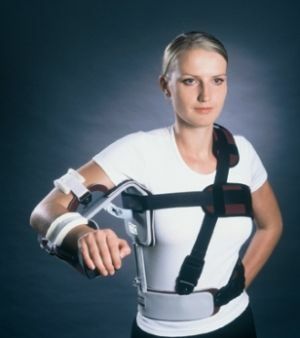
Bandage for shoulder fracture
If the fracture of the shoulder is not accompanied by a displacement or damage to the soft tissues, the limb is fixed using a diverticulum.
In cases of slight bias, the specialists use a removable langet.
Such frivolous fractures allow us to go through physical therapy sessions for a quick "healing" in 3-4 days.
A week after the fracture, the patient begins a course of restoring the elbow joint with the help of massage and other physiotherapy sessions. After 3 weeks or a month, plaster and additional parts are removed.
Treatment of fracture with bias
Restoration of damaged bone occurs in a hospital with a regular intake of pain medications and radiology as an observation. Of course, the sick person is restored to the original state of the fragments with the help of local anesthetic or general anesthesia with subsequent fixation.
From the first person to recover, he should move his fingers, and after 4 weeks he attends physiotherapy sessions. Minimum stay in gypsum is 6-7 weeks.
Operative intervention
If in the process of injury the humerus is divided into small pieces, the usual restoration will not help. Here, restoration operations are carried out using knitting needles, screws or plates.
Sometimes the Ilizarov apparatus is used to hold the fragments until they are fully connected. Also, fixing the injured limb until complete recovery is carried out, which lasts for several months.
Only after 3-4 weeks a person begins to undergo additional physiotherapy procedures. The entire course of treatment can take several months.
Complications and prognosis
Fracture of the shoulder is rarely accompanied by complications, since the slightest movements cause pain, which means that a person instinctively tries not to move his hand and immediately seeks a doctor for help. 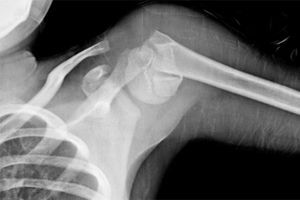
As for the forecasts, we should not speak about unfavorable outcomes. With timely and qualified assistance, a person quickly restores and does not suffer unpleasant consequences. Exceptions can constitute medical errors, both in the diagnosis and in the treatment.
Remember that with any assistance provided during the injury a person should feel a great deal of relief.
If this is not observed and even fixing the limb with gypsum gives pain, contact another specialist for a second examination and diagnosis.


